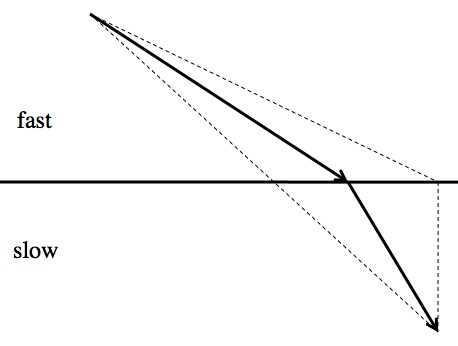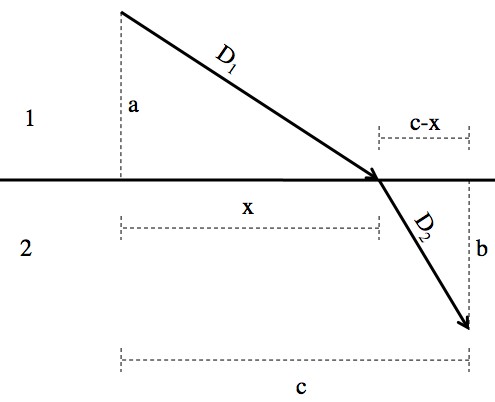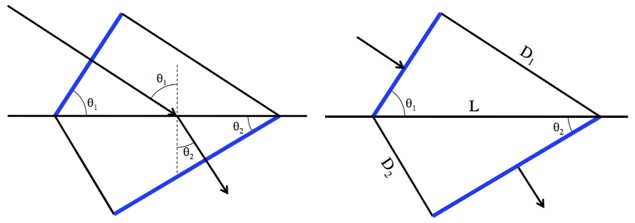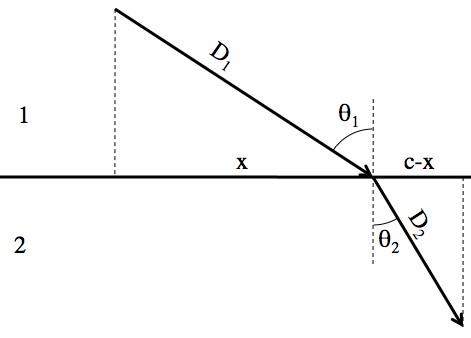Physicist: Light travels at different speeds in different materials. When you shine a beam of light from one material into another (like from air to water) it bends in such a way that the path it takes from one point to another requires the least possible time.

Taking a straight line means traveling through a lot of the “slow material”. Traveling through lots of “fast material” to make the path through the slow material as short as possible means taking a longer path overall (and taking more time). The path of “least time” is in between.
This should come across as deeply spooky. A particle that somehow “scouts the future” and then picks the fastest path to get where it’s going seems impossible.
And to be fair: it is. The crux of the problem is (as with damn near everything) wave/particle-ness. Particles can’t magically know what the shortest path will be, but waves find it “accidentally” every time.
First, check out the path that the “principle of least time” carves out. What follows is math, which some people dig. If you skip over the block of calculations, you won’t really miss anything.
The time, T, that it takes to traverse a path is D/V, where D is the length of the path and V is the speed.

The picture for the derivation below. In the top material the wave speed is “V1” and in the bottom “V2”. With a little calculus, by sliding x back and forth you can find the “minimum-time path”.
By changing x you change the path, and the amount of time T it takes to move along that path. Calculus wonks may know that to find an “extremum” (either a maximum or a minimum), all you have to do is find the derivative, set it to zero, and solve. With any luck, those same wonks will be forgiving if I just declare that the following derivation finds the minimum time (and not a maximum or something) instead of proving that it’s a minimum.
The exact value of x isn’t particularly useful. What is useful are those angles. The statement “” is Snell’s law.
Snell’s law should look familiar to anyone who’s used to talking about waves going from one material to another. It describes, for example, the bending of light as it crosses between air and water.
So, the law of “least propagation time” is nothing more than a different, and far more difficult, way of stating “Snell’s law”. And again, if you’re talking about a particle, it’s hard not to think that the particle is testing each path in advance, and then taking the quickest one.
However, you can derive the same result by thinking about how waves propagate. Waves (light, sound, water, whatever) propagate perpendicular to their wave crests. Take a second: picture an ocean wave.
As one side of the crest enters a different material it changes speed. When different parts of the wave are traveling at different speeds the wave front as a whole changes direction.

Top: a section of the wave starts to hit the boundary between two materials. Middle and Bottom: In the second material the wave moves slower. Since one side of the wave is moving faster than the other the wave front “swings around” into a new direction.
A good (but not quite accurate) way to picture the situation is to think of a car where the wheels on one side spin faster than the wheels on the other. Naturally, the car’ll turn to the side.

Left: the important angles, and where they show up in the triangles. Right: the angles and lengths involved in the math below.
You can be a bit more exact about this. The diagrams above describe a piece of the wave crest from the moment when one side hits the boundary, to the time the other side hits. Call that time “T” (why not?).
The distance that the top end of the piece-of-crest travels is D1 = V1T, and the distance the bottom tip travels is D2 = V2T. Now, using the definition of sine: and
.
Combining these you get:
Holy crap! Snell’s law again! Having the same result means that, in terms of behavior, the two approaches are indistinguishable. So, instead of a spooky particle scouting every path looking for the quickest one, you have a wave that’s just doing it’s thing.
The principle of least time is a cool idea, and actually makes the math behind a lot of more complicated situations easier, but at it’s root is waviness.








Pingback: Q: If light slows down in different materials, then how can it be a universal speed? | Ask a Mathematician / Ask a Physicist
Pingback: Eleventh Linkfest
Pingback: தமிழ இயல்பு: ஸ்னெல் ஒளித்தடம் + ஸிப்ஃப் மானுட இயல்புக் கோட்பாடுகள் | ஒத்திசைவு...
Pingback: Q: Why are the laws of quantum mechanics so strange? Does it mean that we’re missing something? | Ask a Mathematician / Ask a Physicist
Pingback: What’s Wrong With Shortcuts? (Ep. 483) - Freakonomics
Pingback: What’s Incorrect With Shortcuts? (Ep. 483) - Freakonomics - Tradenews
Pingback: What’s Wrong With Shortcuts? (Ep. 483) – Business News
Pingback: What’s Flawed With Shortcuts? (Ep. 483) - Freakonomics - Tradenews